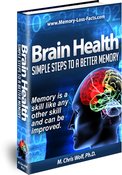Brain Stem Injury
By M. Chris Wolf, PH.D. and Memory Loss Staff
What is a brain stem injury? The brain stem regulates the basic bodily functions necessary for life including respiration and cardiac activity. The brain stem serves as a sort of neural transformer, a fuse point for the central nervous system, modifying the ubiquity and path of sensory data, in the form of electrical impulse and neurotransmitters. Many basic brain activities essential to life are controlled by regions in the brain stem, thus any type of brain stem injury requires immediate medical attention.
Structure and Function of the Brain Stem
The brain stem is the lowermost part of the brain, located above the spinal cord. A brain stem injury will effect the midbrain, medulla, and pons - the three parts into which the brainstem is divided anatomically. They are grouped together by virtue of proximity, similar function, and interoperation. Despite its relative small size, the brainstem is in fact an extremely dense nexus for the entire nervous system.
The Medulla oblongata acts as a two-way path for conducting information between the spinal cord and higher brain centers. It also houses the cardiac center, which regulates heartrate and intensity of the heart's contractions. The medullary rhythmicity area adjusts the rate of breathing, and the vasomotor center regulates the diameter of blood vessels.
The Pons is an important information channel and plays a role in respiration. Among many other actions, the midbrain contains the reticular formation, which is responsible for maintaining consciousness. Ten of the cranial nerves, which control sensory experience in the face and head, among other things, attach to the brain stem.
New research has begun to reveal an even more subtle but dynamic relationship between brain stem health and emotional affect. The vital, central role of the brain stem cannot be overemphasized.
Injury to the Brain Stem
Because of its pivotal position and executive function in so many involuntary, as well as motor and higher cognitive, processes, injuries to the brainstem carry a special potential to prove detrimental to neurological function.
An injury to the brain stem can be a result of external trauma, or an internal pathology such as an aneurysm, stroke, or developmental disorder such as hydroencephalitis. Depending on the location and extent of tissue damage done, symptoms of stem injury can range from dysphagia (difficulty in swallowing food and water) to compound amnesia, to vegetative state and death.
As it is responsible for the very biological processes that support life at a very fundamental level, any injury to the brain stem ought to be encountered with the utmost care. Severed brain cells are dead forever; but merely damaged neurons begin repairing as soon as trauma is alleviated and the patient in stable condition. Initial neurological symptoms can potentially improve if proper care is taken to allow neurogenesis.
Improve Brain Health - Click Here
For more information about this topic consider these resources:
Sports Neuropsychology: Assessment and Management of Traumatic Brain Injury by Ruben J. Echemendia PhD (Editor)
The Brain That Changes Itself: Stories of Personal Triumph from the Frontiers of Brain Science by Norman Doidge
Traumatic Brain Injury (Rehabilitation Medicine Quick Reference) David Cifu MD and Deborah Caruso MD - Ralph Buschbacher MD (Series Editor)
Return from Brain Stem Injury to Brain Injury
OR
Memory Loss Facts
Our Sponsors



Click Here Now
LIKE THIS SITE?
Interested in having your own internet home based business?





